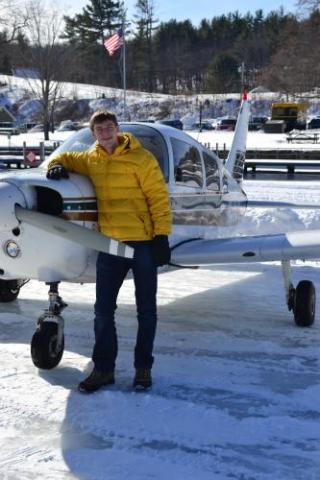
Chris grew up in Los Angeles and studied Physics at UC Santa Barbara, graduating in 2012. Before coming to Yale, he worked on a piezoelectric control system for microfluidic particle detectors in Andrew Cleland’s group at USCB. The work overlapped with the quantum information field, an exciting place to be, where Chris really expanded his horizons.
In 2015, he joined Rob Schoelkopf group in 2015 as NSF Graduate Research Fellow to develop coherent hardware modules that currently serve as the basis for a modular quantum computing architecture. The goal of his work is to establish communication between computing nodes in a network that could grow to become a full-scale quantum computer. Normally, the quantum information in the lab systems is confined to light fields, effectively bouncing back and forth between mirrors, and nearby elements are required to probe or interact with that information. Accessing the information that way is only possible when the system has a few computing elements (qubits) but becomes cumbersome for the hundreds that are required to make this machine useful.
Instead, Chris and his colleagues effectively removed one of the mirrors and let the stored energy fly off down a wire. When it gets to another device, they undo the process to catch and confine it once again. This means they can shuttle quantum information around, just like between computers connected in a network. By making all the “computers” alike, and connecting as many as one like together, it will form one big, networked quantum “supercomputer” that can solve bigger problems.
“Some people refer to the end result of our research as the quantum Internet.” says Chris. “That doesn’t mean we are going to be watching cat videos on YouTube in which they’re simultaneously alive and dead, though. Rather, I hope that our architecture for communicating between (and protecting) logical qubits in a quantum computer becomes so robust and commonplace that people don’t even think about it anymore. It will be just one piece of a platform, combined with work of all my colleagues, that forms the backbone of a powerful quantum machine. If this kind of conversion can be extended beyond the microwave domain, then quantum computers could spread into the cloud.”
After his defense on Tuesday April 24 2018, Chris will be moving to Zürich to work as a postdoc in the lab of Jonathan Home, still in quantum information, but switching to a different platform: trapped ions.
Fun fact
In Switzerland, Chris’ soon-to-be new home, it is illegal to own just a single guinea pig (it must have a companion). Also, if he decide to have a dog, he’ll have to pay tax based on its weight!
Favorite publication
Karlsson, B.C.G., Friedman, R., Dilution of whisky - The molecular perspective, Scientific Reports, 7 (1), art. no. 6489 (2017)
Latest publication
Axline, C. J., Burkhart, L. D., Pfaff, W., Zhang, M., Chou, K., Campagne-Ibarcq, P., Reinhold, P., Frunzio, Luigi, Girvin, S.M., Jiang, Liang, Devoret, M.H., Schoelkopf, R.J., On-demand quantum state transfer and entanglement between remote microwave cavity memories. Nature Physics (2018)
Most cited
Reagor, M., Paik, H., Catelani, G., Sun, L., Axline, C., Holland, E., Pop, I.M., Masluk, N.A., Brecht, T., Frunzio, L., Devoret, M.H., Glazman, L., Schoelkopf, R.J., Reaching 10 ms single photon lifetimes for superconducting aluminum cavities, Applied Physics Letters, 102 (19), art. no. 192604 (2013)